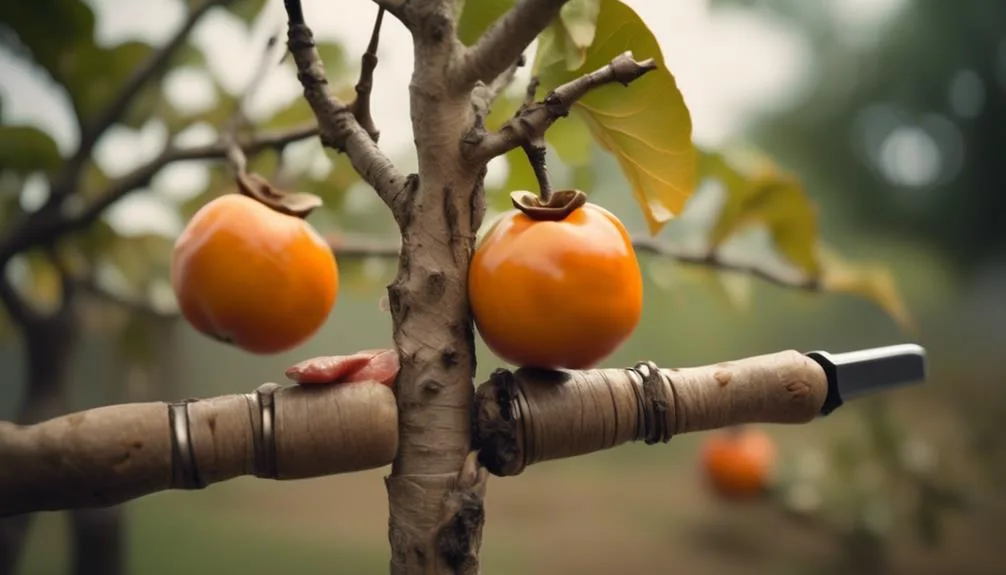Many gardeners wonder if it's possible to graft persimmon trees, aiming to combine different varieties' traits for better fruit.
Can it be done, and how?
Let's explore the world of grafting persimmon trees to find out.
Key Takeaways
- There are several grafting methods that can be used for persimmon trees, including whip and tongue grafting, cleft grafting, bark grafting, and T-budding and chip budding.
- The best time to graft persimmon trees is during late winter to early spring when the trees are dormant but showing signs of new growth, and mild weather conditions are present. Extreme heat or drought should be avoided.
- Factors that can affect the successful grafting of persimmon trees include the grafting techniques used, the selection of compatible rootstock, the age, vigor, and disease resistance of the rootstock, proper alignment between the scion and rootstock, and weather conditions and pests.
- To ensure successful grafting of persimmon trees, it is recommended to use the whip-and-tongue grafting technique, collect scion wood from healthy, disease-free trees, choose compatible rootstocks, protect the graft union, and follow proper grafting techniques and practices. Rootstock selection is also important as it determines the compatibility with the scion, disease resistance, and overall health and adaptability of the grafted tree.
Yes, Persimmon Trees Can Be Grafted
Grafting persimmon trees is a straightforward and effective way to propagate your favorite varieties. Understanding the different methods such as whip and tongue, cleft, or bark grafting can help you achieve the best results. Each technique has its own advantages, so it's important to choose the one that suits your specific needs.
Rootstock selection plays a crucial role in the success of grafting persimmon trees. The rootstock should be compatible with the scion, have good disease resistance, and adapt well to your local soil and climate conditions.
Suitable Grafting Methods for Persimmon Trees
When choosing suitable grafting methods for persimmon trees, consider the specific needs of your favorite varieties and the advantages offered by different techniques such as whip and tongue, cleft, or bark grafting.
Whip and tongue grafting is ideal for joining rootstock and scion of similar sizes, providing a strong union.
Cleft grafting, on the other hand, is suitable for larger rootstocks and allows for multiple grafts on a single tree.
Bark grafting is effective for older trees and works well with scions of different diameters.
Additionally, when considering budding techniques, such as T-budding or chip budding, ensure they align with the persimmon tree's growth habits.
Moreover, rootstock selection is crucial, as it influences the overall health, size, and adaptability of the grafted persimmon tree.
Best Time to Graft Persimmon Trees
Wondering when is the best time to graft persimmon trees for optimal success and growth? The grafting season for persimmon trees typically occurs in late winter to early spring, when the trees are still dormant but beginning to show signs of awakening. This is the ideal time to utilize grafting techniques for persimmon trees, as the sap begins to flow, promoting rapid healing and successful union between the scion and rootstock.
Some key points to consider for the best time to graft persimmon trees include:
- Late winter to early spring is the optimal grafting season.
- Choose a time when the tree is dormant but starting to show signs of new growth.
- Ensure the weather is mild and not excessively cold.
- Avoid grafting during periods of extreme heat or drought.
Grafting during the recommended season and under favorable conditions will greatly enhance the success of your persimmon tree grafts.
Factors Affecting Successful Grafting of Persimmon Trees
To ensure successful grafting of persimmon trees, it's essential to consider various factors that can influence the outcome of the process.
Grafting techniques play a crucial role in the success of persimmon tree grafting. Selecting the right technique, such as whip and tongue or cleft grafting, can significantly impact the union between the scion and rootstock.
Additionally, the selection of the rootstock is a critical factor. The rootstock should be compatible with the scion variety to ensure successful grafting. Consider factors such as the rootstock's age, vigor, and disease resistance when making your selection.
Tips for Successful Grafting of Persimmon Trees
For successful grafting of persimmon trees, it's crucial to ensure proper scion and rootstock alignment to promote a strong union. Here are some essential tips for successful grafting:
- Use the whip-and-tongue grafting technique for persimmon trees to maximize the contact area between the scion and rootstock.
- Ensure that the scion wood is collected from healthy, disease-free trees to increase the likelihood of successful grafting.
- Choose rootstocks that are compatible with the scion variety to promote successful grafting and long-term tree health.
- Keep the graft union protected from harsh environmental conditions and pests to improve the chances of successful grafting.
Conclusion
In the world of persimmon trees, grafting opens up a realm of possibilities. With the right methods and timing, successful grafting is well within reach. Remember, tree health and proper care are key factors in the process.
By mastering the art of grafting, you can nurture a thriving orchard. Happy grafting, and may your persimmon trees flourish with bountiful harvests!

